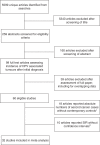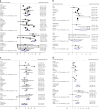Increased risk of second cancers at sites associated with HPV after a prior HPV-associated malignancy, a systematic review and meta-analysis
- PMID: 30482913
- PMCID: PMC6342987
- DOI: 10.1038/s41416-018-0273-9
Increased risk of second cancers at sites associated with HPV after a prior HPV-associated malignancy, a systematic review and meta-analysis
Abstract
Background: High-risk human papilloma viruses (HPV) are a causative agent of anogenital and oropharyngeal cancers. Patients treated for a preinvasive or invasive HPV-associated cancer may be at increased risk of a second such malignancy.
Methods: We performed a systematic review and random effects meta-analysis to estimate the risk of HPV-associated cancer after prior diagnosis. Studies reporting second cancers at anogenital and oropharyngeal sites after prior diagnoses (preinvasive/invasive HPV-associated cancer) were identified. Studies reporting standardised incidence ratios (SIRs) were included in formal meta-analyses of second cancer risk. (PROSPERO ID: CRD42016046974).
Results: Searches returned 5599 titles, including 60 unique, eligible studies. Thirty-two (98 comparisons) presented SIRs for second cervical, anal, vulvo-vaginal, penile, and/or oropharyngeal cancers, included in the meta-analyses. All studies (and 95/98 comparisons) reported increased cancers in the population with previous HPV-associated cancer when compared to controls. Pooled SIRs for second primary cancers ranged from 1.75 (95% CI 0.66-4.67) for cervical cancer after primary anal cancer, to 13.69 (95% CI 8.56-21.89) for anal cancer after primary vulvo-vaginal cancer.
Conclusions: We have quantified the increased risk of second HPV-associated cancer following diagnosis and treatment for initial cancer or preinvasive disease. This has important implications for follow-up, screening, and future therapeutic trials.
Conflict of interest statement
The authors declare no competing interests.
Figures



Comment in
-
Reply to Comments on "Increased risk of second cancers at sites associated with HPV after a prior HPV-associated malignancy, a systematic review and meta-analysis".Br J Cancer. 2019 Apr;120(9):956. doi: 10.1038/s41416-019-0440-7. Epub 2019 Mar 26. Br J Cancer. 2019. PMID: 30911086 Free PMC article. No abstract available.
-
Comment on "Increased risk of second cancers at sites associated with HPV after a prior HPV-associated malignancy, a systematic review and meta-analysis".Br J Cancer. 2019 Apr;120(9):954-955. doi: 10.1038/s41416-019-0437-2. Epub 2019 Mar 26. Br J Cancer. 2019. PMID: 30911087 Free PMC article. No abstract available.
-
Comment on "Increased risk of second cancers at sites associated with HPV after a prior HPV-associated malignancy, a systematic review and meta-analysis".Br J Cancer. 2019 Apr;120(9):952-953. doi: 10.1038/s41416-019-0439-0. Epub 2019 Mar 26. Br J Cancer. 2019. PMID: 30911088 Free PMC article. No abstract available.
Similar articles
-
Risk of human papillomavirus-associated cancers among persons with AIDS.J Natl Cancer Inst. 2009 Aug 19;101(16):1120-30. doi: 10.1093/jnci/djp205. Epub 2009 Jul 31. J Natl Cancer Inst. 2009. PMID: 19648510 Free PMC article.
-
Potential role of human papillomavirus in the development of subsequent primary in situ and invasive cancers among cervical cancer survivors.Cancer. 2008 Nov 15;113(10 Suppl):2919-25. doi: 10.1002/cncr.23746. Cancer. 2008. PMID: 18980275
-
Evidence on the prevalence, incidence, mortality and trends of human papilloma virus-associated cancers in sub-Saharan Africa: systematic scoping review.BMC Cancer. 2019 Jun 11;19(1):563. doi: 10.1186/s12885-019-5781-3. BMC Cancer. 2019. PMID: 31185951 Free PMC article.
-
Elevated risk of human papillomavirus-related second cancers in survivors of anal canal cancer.Cancer. 2017 Oct 15;123(20):4013-4021. doi: 10.1002/cncr.30828. Epub 2017 Jun 13. Cancer. 2017. PMID: 28608917
-
Human papillomavirus infection by anatomical site among Greek men and women: a systematic review.Eur J Cancer Prev. 2016 Nov;25(6):558-71. doi: 10.1097/CEJ.0000000000000207. Eur J Cancer Prev. 2016. PMID: 26628088 Free PMC article.
Cited by
-
Human Papillomavirus and Anal Cancer: Prevalence, Genotype Distribution, and Prognosis Aspects from Midwestern Region of Brazil.J Oncol. 2019 Sep 18;2019:6018269. doi: 10.1155/2019/6018269. eCollection 2019. J Oncol. 2019. PMID: 31641354 Free PMC article.
-
Association of First Primary Cancer With Risk of Subsequent Primary Cancer Among Survivors of Adult-Onset Cancers in the United States.JAMA. 2020 Dec 22;324(24):2521-2535. doi: 10.1001/jama.2020.23130. JAMA. 2020. PMID: 33351041 Free PMC article.
-
Sequential acquisition of human papillomavirus infection between genital and oral anatomic sites in males.Int J Cancer. 2021 Oct 1;149(7):1483-1494. doi: 10.1002/ijc.33732. Epub 2021 Jul 14. Int J Cancer. 2021. PMID: 34224588 Free PMC article.
-
Risk of extracolonic second primary cancers following a primary colorectal cancer: a systematic review and meta-analysis.Int J Colorectal Dis. 2022 Mar;37(3):541-551. doi: 10.1007/s00384-022-04105-x. Epub 2022 Feb 12. Int J Colorectal Dis. 2022. PMID: 35152308 Free PMC article.
-
Clinical characteristics and prognosis of anal squamous cell carcinoma: a retrospective audit of 144 patients from 11 cancer hospitals in southern China.BMC Cancer. 2020 Jul 21;20(1):679. doi: 10.1186/s12885-020-07170-z. BMC Cancer. 2020. PMID: 32693779 Free PMC article.
References
Publication types
MeSH terms
Grants and funding
LinkOut - more resources
Full Text Sources

